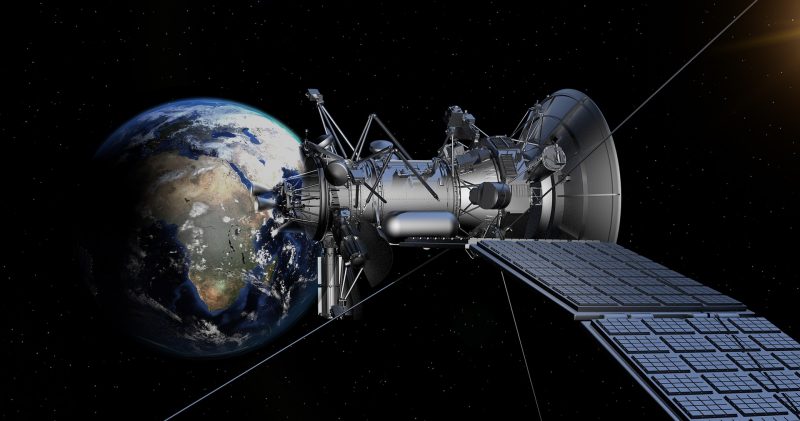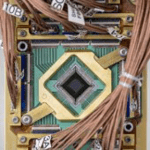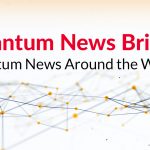Inside Quantum Technology’s Inside Scoop: Quantum and the Space Industry

The intersection of quantum computing with the space industry allows two next-generation technologies to collide. With phenomena like quantum entanglement, quantum devices in space, such as satellites, can enable the next stage of quantum technology: the quantum internet. According to quantum computing company IonQ‘s Chief Scientist Chris Monroe: “Two use cases for quantum tech in space include (a) secure communications, even over multiple nodes, ensured by the laws of quantum physics, and (b) distributed sensors that can measure certain quantities with very low noise. In either case, the communication channels would require quantum computers at each node as repeater circuitry, thus obviating the need for small lightweight quantum computer systems.”
Currently, the quantum satellites being developed use QKD (Quantum Key Distribution), which means that a set of keys are shared between the receiver and sender. This allows for a more secure connection. Future satellite projects hope to use quantum entanglement to create an even more secure and faster link. According to a 2022 Forbes article: “The quantum-entangled link allows for the teleportation of information at the speed of light, but also means that any attempt to intercept the signal immediately severs the link, making hacking impossible.” These more secure linkages can transform many different industries. Former NASA rocket scientist Olympia LePoint explained that “we will most likely see satellites converted to harness Quantum Communications which will prevent banking data, hospital data, and national security breaches.” While these entangled connections may be game-changing, they are tricky to maintain, as quantum entanglement is quite fragile. As you’ll see in the following sections, many countries are working to make quantum-entangled connections in space happen, just using different methods.
China’s Race to Space
China became the first to send a QKD satellite to space. Called Micius, the satellite launched in 2016 and could connect itself to ground stations over 1200 km apart. In July of 2022, China launched a second QKD satellite that weighs around one-sixth of Micius. “According to Science Daily, in August, China’s Tiangong 2 Space Lab transmitted quantum-encryption keys to four ground stations able to receive quantum keys from the orbiting Micius satellite, which uses the space station as a repeater,” the Forbes article stated. As China is working to pull ahead in the quantum race, these two satellites may help give them a possible advantage.
Europe’s (The European Space Agency) Space Industry
Not to be outdone by China, the European Space Agency (ESA) has announced its own plans to launch a QKD satellite by 2024. The system, called Eagle-1, will spend the first three years after launch in orbit to run diagnostics on the technology. The actual satellite is provided by the Italian company SITAEL, while German-based Tesat Spacecom is providing the QKD payload. The satellite will be run by SES S.A., a French-Luxembourgish telecommunications company. “European security and sovereignty in a future world of quantum computing are critical to the success of Europe and its member states,” explained SES SA. CEO Steve Collar. He added that the plan is “to advance quantum communications and develop the Eagle-1 system to support secure and sovereign European networks in the future.” Besides these three companies, 17 others will be involved in the ESA’s plan to launch a QKD satellite into space.
The U.S.’s (NASA) Space Industry
While the US is working on its own QKD satellites, the National Aeronautics and Space Administration (NASA) is focusing on detecting entanglement in space. The project is called SEAQUE (Space Entanglement Annealing Quantum Experiment) and it will see if two photons can be entangled in space. According to SEAQUE’s principal investigator, Dr. Paul Kwait of the University of Illinois Urbana-Champaign: “The advantage of trying to close the link from space is that the intensity of light basically falls off and therefore in the loss is much less going through free space than it would be trying to send a signal through fiber.” The researchers plan to launch the SEAQUE system (no bigger than a milk carton) late this year. The system will then be attached to the outside of the International Space Station (ISS). There the researchers can test for entanglement.
“SEAQUE is going to create entanglement through a process called spontaneous parametric down-conversion, in which a single photon goes through a nonlinear crystal and produces two daughter photons that are lower energy” stated a 2022 Popular Science article. For each photon that is inputted, a pair of entangled daughter photons should be released. The researchers will use a detector to count the number of photons generated by the entangled source. NASA also plans to test a different technique where SEAQUE can help the transmitters and receivers “self-heal” from space radiation. If both these experiments go well, SEAQUE would be just the first in many phases to establish an entangled quantum internet.
Helping the Space Industry Develop a Quantum Internet
With long-distance entangled connections, data, such as telescope images, can be sent to Earth from space at a faster rate. This enables many companies and governments to work on an overarching structure for these connections, or a quantum internet. “We are closer to seeing the Quantum Internet coming into existence,” LePoint added. “We see this in NASA’s 2020 breakthrough science in being the first to create long-distance teleportation. Then in 2021, a team of hologram doctors was ‘holoported’ to space to visit astronauts living aboard the International Space Station (ISS) using this long-distance teleportation. NASA is setting the groundwork for the Quantum Internet, which will lead to quantum communications for hologram communication and technology.” As the space industry works to make space more quantum-friendly, the rest of the quantum industry will no doubt follow the progress, hoping to leverage the technology in the future.
Kenna Hughes-Castleberry is a staff writer at Inside Quantum Technology and the Science Communicator at JILA (a partnership between the University of Colorado Boulder and NIST). Her writing beats include deep tech, the metaverse, and quantum technology.























